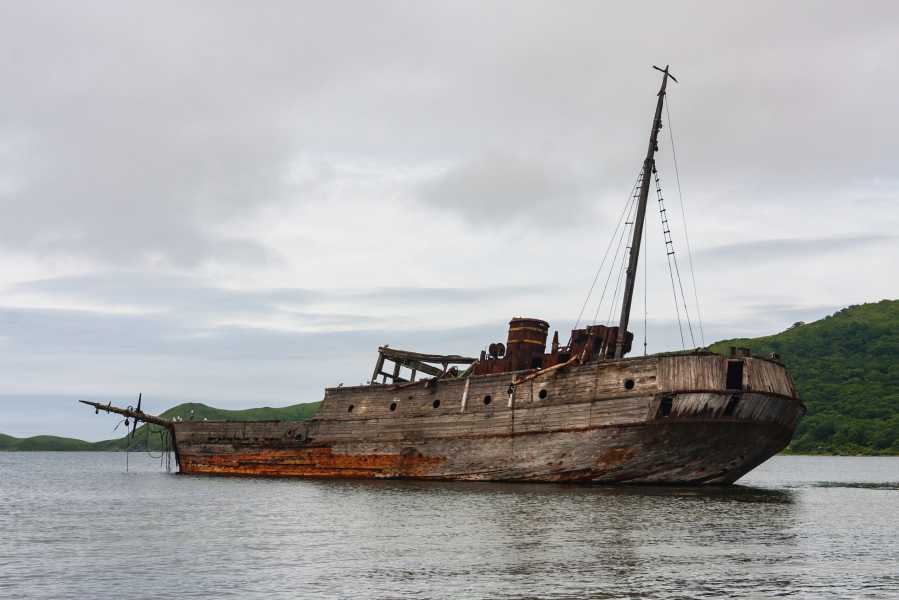From TAC’s Bookshelf: How do you say “Save the Whales” in Russian?

A wrecked Soviet whaling ship in Vityaz Bay. (Evgenii Abramovich/Shutterstock)
“Pro-nature but not crazy about it” is probably how most TAC readers would describe their position on the environment. We like trees and animals and consider America’s natural beauty an inheritance worth preserving, but we’re not about to hobble the economy for the sake of the snail darter.
What Americans need to remember is that, in the eyes of the rest of the world, our basic love of nature seems pretty crazy. Search the historical record of the 19th century for laws against animal cruelty, government-established wilderness areas, camping and hiking as a form of recreation—you will find them in Europe and America and almost nowhere else.
One rival civilization that does share our love of nature is Russia. It’s a peculiarity we have in common. The tsarist empire created its first natural parks around the same time we created ours, calling them zapovedniki, places to be kept forever wild. The Russian Society for the Protection of Animals was founded a year before ours, in 1865. Russian literature has many memorable stories about animals and nature, albeit in a sentimental Slavic vein as opposed to the moralizing Anglo-American register.
How does that square with the Soviet Union having committed one of the greatest environmental crimes of the 20th century, the killing of hundreds of thousands of whales in the 1960s and ’70s, which pushed some species to the point of extinction?
That crime, and how it was hidden for decades and ultimately exposed, is the subject of Red Leviathan: The Secret History of Soviet Whaling (2022) by Ryan Tucker Jones. A professor of history at the University of Oregon, his previous book was about the extinction of the Steller’s sea cow due to similarly rapacious hunting practices during the tsarist era.
The modern era of whaling began just as the Soviet Union was born. The stern slipway, invented in 1922, allowed whales to be hauled onto the deck and processed on board. This and similar technological innovations put an end to whaling’s romantic era and brought the age of the floating factory.
America had dominated whaling in the 19th century—killing 300,000 whales at a time when Russian whalers had killed almost none, Jones notes—but by the turn of the century our fleet was in decline. The port of New Bedford, the last holdout in New England, sent out its last whaler in 1927.
Russia relished its role as the leader of the 20th century whaling industry. Stalin and Khrushchev eagerly put a communist spin on it, crediting their achievements to the socialist work ethic. Captain Aleksei Solyanik, the commander of the Soviet whaling fleet, became a national hero and a celebrity. The ships themselves were held up as feats of engineering and sheer size, which indeed they were. The whaling ship Slava had a crew of 600; the Sovietskaia Ukraina, 1,000.
The International Whaling Commission was established in 1946, with a mandate to protect the ocean’s stocks for the future and put a stop to unsustainable practices like the killing of pregnant cows. At first the Soviets seemed eager to cooperate with the IWS. One American observed in retrospect, “The Russians had shown a very compromising spirit in pelagic whaling, if not in other fields. In fact, the Russians had a very fair record in conservation and seemed ready to agree to whatever controls other nations accepted on whaling.”
But soon the toxic imperatives of socialist central planning came into operation. Production was valued above all else. The more, the better, was the rule. Fat and oil from the whale carcasses was in high demand in the home market for margarine, soap, pharmaceuticals, and other consumer products.
In order to evade international quotas, the Soviets falsified their reports and kept the true numbers to themselves. Officially, the Soviets killed 360,000 whales in the postwar period; in reality, it was closer to 550,000.
The heroes of Jones’s book are the Soviet scientists who blew the whistle on their country’s overfishing. They gathered secret internal documents showing real catch numbers and compared them to the fake ones submitted to the IWC. One of these men, Yuri Mikhalev, told Jones how, in retaliation, “Soviet bureaucrats closed down his biological laboratory, and his health and marriage suffered.”
Subscribe Today Get daily emails in your inbox Email Address:
But Mikhalev did not stop there in his comments to Jones. He also had harsh words for the Americans, who in his eyes used Soviet marine crimes as a cudgel without reflecting on their own past crimes or the ongoing crimes of their geopolitical allies, namely Japan. Jones says Mikhalev was reluctant to help him for this reason: “The episode had become another of many in which the West cynically and opportunistically embarrassed Russia. Mikhalev told me he was sure my book would do more of the same.”
Mikhalev was too cynical about Jones’s book. It is deeply sympathetic to Soviet whalers, puts their conduct in historical context, and concludes that the environmental crimes of the Soviet whaling industry were unique in the 20th century but not unique in modern history. It emphasizes that the recovery of whale populations in the last five decades has been a great environmental success story, one that every nation involved can feel proud of.
One thing Jones reports that confirms the kinship between our two nations: Moby-Dick was translated into Russian in 1961 and published in a Soviet edition with Rockwell Kent’s illustrations, and it became a hit. They even made a Russian film version in 1972. “Melville’s novel proved a useful source of mutual comprehension,” Jones writes. Any nation that appreciates Moby-Dick can’t be all that foreign.
Sourse: theamericanconservative.com






